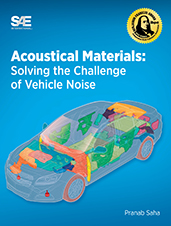Technical Paper
Rationale and Process for Developing an SAE Damping Test Method
2023-05-08
2023-01-1050
The paper discusses the process of developing an SAE damping measurement test method that is suitable for testing bars that are not made of steel or are difficult to measure with the traditional Oberst bar method. The method is based on measuring mechanical impedance (force over velocity) of a vibrating bar. The bar is excited at the center using a shaker and hence it is also called a CenterPoint method. The paper discusses the round robin tests that have been conducted so far and discusses the test results that will help develop the standard. The paper discusses the variability of the round robin test results within a laboratory, between laboratories, as well as the coefficient of variation for these measurements. The paper also discusses various parameters that should be carefully monitored in this study, that otherwise could affect the precision of the test procedure.

